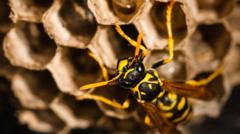A wasp nest containing radiation levels up to ten times beyond permitted limits was discovered at the Savannah River Site (SRS), a former producer of components for US nuclear weapons, as detailed in a report released by the US Department of Energy. The findings emerged from a routine inspection conducted on July 3, prompting immediate action to spray and contain the nest as radiological waste, though no wasps were present upon discovery.
Officials have clarified that the radioactive contamination is not linked to a nuclear waste leak, assuring that there has been no adverse effect on the surrounding environment or local populations. However, environmental advocates have voiced concerns regarding the response to this incident, highlighting a lack of transparency from the government.
Investigators traced the elevated radiation levels back to "onsite legacy radioactive contamination"—residual radioactivity from the site's past operations during the Cold War, when it was actively engaged in plutonium production for nuclear armaments. Despite ongoing operations for nuclear energy material, the facility still harbors millions of gallons of liquid nuclear waste.
According to the energy department, the wasps inhabiting the nest would have received significantly lower radiation exposure compared to the nest itself, given that they typically remain within a few hundred feet of their home. The SRS spans over 310 square miles, which further reduces the likelihood of the insects venturing outside its boundaries.
Current monitoring shows no contamination beyond the immediate area of the nest, and the report reassures that there have been no impacts on workers, the environment, or the public. Nevertheless, Savannah River Site Watch, an organization overseeing the site’s activities, has expressed dissatisfaction over the absence of clear answers regarding the origins of the radioactive material and whether there might be a leak from the waste tanks.
Overall, the incident has reignited discussions on safety protocols at sites historically linked to nuclear weapon production, with the Savannah River Site having generated upwards of 165 million gallons of liquid waste during its operational years—43 tanks are still functional while eight have been closed.


















